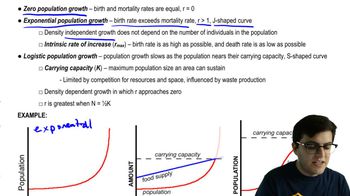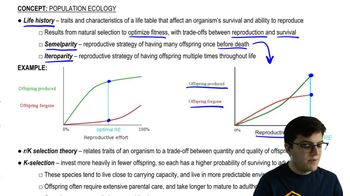Table of contents
- 1. Introduction to Biology2h 40m
- 2. Chemistry3h 40m
- 3. Water1h 26m
- 4. Biomolecules2h 23m
- 5. Cell Components2h 26m
- 6. The Membrane2h 31m
- 7. Energy and Metabolism2h 0m
- 8. Respiration2h 40m
- 9. Photosynthesis2h 49m
- 10. Cell Signaling59m
- 11. Cell Division2h 47m
- 12. Meiosis2h 0m
- 13. Mendelian Genetics4h 41m
- Introduction to Mendel's Experiments7m
- Genotype vs. Phenotype17m
- Punnett Squares13m
- Mendel's Experiments26m
- Mendel's Laws18m
- Monohybrid Crosses16m
- Test Crosses14m
- Dihybrid Crosses20m
- Punnett Square Probability26m
- Incomplete Dominance vs. Codominance20m
- Epistasis7m
- Non-Mendelian Genetics12m
- Pedigrees6m
- Autosomal Inheritance21m
- Sex-Linked Inheritance43m
- X-Inactivation9m
- 14. DNA Synthesis2h 27m
- 15. Gene Expression3h 20m
- 16. Regulation of Expression3h 31m
- Introduction to Regulation of Gene Expression13m
- Prokaryotic Gene Regulation via Operons27m
- The Lac Operon21m
- Glucose's Impact on Lac Operon25m
- The Trp Operon20m
- Review of the Lac Operon & Trp Operon11m
- Introduction to Eukaryotic Gene Regulation9m
- Eukaryotic Chromatin Modifications16m
- Eukaryotic Transcriptional Control22m
- Eukaryotic Post-Transcriptional Regulation28m
- Eukaryotic Post-Translational Regulation13m
- 17. Viruses37m
- 18. Biotechnology2h 58m
- 19. Genomics17m
- 20. Development1h 5m
- 21. Evolution3h 1m
- 22. Evolution of Populations3h 52m
- 23. Speciation1h 37m
- 24. History of Life on Earth2h 6m
- 25. Phylogeny2h 31m
- 26. Prokaryotes4h 59m
- 27. Protists1h 12m
- 28. Plants1h 22m
- 29. Fungi36m
- 30. Overview of Animals34m
- 31. Invertebrates1h 2m
- 32. Vertebrates50m
- 33. Plant Anatomy1h 3m
- 34. Vascular Plant Transport2m
- 35. Soil37m
- 36. Plant Reproduction47m
- 37. Plant Sensation and Response1h 9m
- 38. Animal Form and Function1h 19m
- 39. Digestive System10m
- 40. Circulatory System1h 57m
- 41. Immune System1h 12m
- 42. Osmoregulation and Excretion50m
- 43. Endocrine System4m
- 44. Animal Reproduction2m
- 45. Nervous System55m
- 46. Sensory Systems46m
- 47. Muscle Systems23m
- 48. Ecology3h 11m
- Introduction to Ecology20m
- Biogeography14m
- Earth's Climate Patterns50m
- Introduction to Terrestrial Biomes10m
- Terrestrial Biomes: Near Equator13m
- Terrestrial Biomes: Temperate Regions10m
- Terrestrial Biomes: Northern Regions15m
- Introduction to Aquatic Biomes27m
- Freshwater Aquatic Biomes14m
- Marine Aquatic Biomes13m
- 49. Animal Behavior28m
- 50. Population Ecology3h 41m
- Introduction to Population Ecology28m
- Population Sampling Methods23m
- Life History12m
- Population Demography17m
- Factors Limiting Population Growth14m
- Introduction to Population Growth Models22m
- Linear Population Growth6m
- Exponential Population Growth29m
- Logistic Population Growth32m
- r/K Selection10m
- The Human Population22m
- 51. Community Ecology2h 46m
- Introduction to Community Ecology2m
- Introduction to Community Interactions9m
- Community Interactions: Competition (-/-)38m
- Community Interactions: Exploitation (+/-)23m
- Community Interactions: Mutualism (+/+) & Commensalism (+/0)9m
- Community Structure35m
- Community Dynamics26m
- Geographic Impact on Communities21m
- 52. Ecosystems2h 36m
- 53. Conservation Biology24m
50. Population Ecology
Introduction to Population Ecology
Problem 14a
Textbook Question
Textbook QuestionSCIENTIFIC THINKING Another hypothesis for snowshoe hare population cycles proposes that they are caused by sunspot activity. According to this hypothesis, sunspot activity affects the chemicals present in the plants eaten by hares, which in turn affects the quality of the food. What testable predictions are generated by this hypothesis?
 Verified step by step guidance
Verified step by step guidance1
Identify the correlation between sunspot activity and the chemical composition of plants: Begin by collecting data on sunspot activity over a period of time and analyze the chemical composition of plants that are part of the snowshoe hare's diet during the same periods.
Examine the nutritional quality of the plants: Conduct laboratory tests to determine if there are changes in the nutritional content of the plants (such as protein levels, toxic compounds, etc.) that correlate with changes in sunspot activity.
Study the health and reproduction rates of snowshoe hares: Monitor the health, reproduction rates, and population dynamics of snowshoe hares during periods of varying sunspot activity to see if there is a noticeable impact correlating with the changes in plant chemistry.
Controlled feeding experiments: Conduct experiments where snowshoe hares are fed plants collected during high and low sunspot activity periods to directly observe the effects of the plant quality on hare health and reproduction.
Statistical analysis: Use statistical methods to analyze the data collected from these experiments to determine if there is a significant correlation between sunspot activity, plant chemistry, and snowshoe hare population cycles.
Recommended similar problem, with video answer:
 Verified Solution
Verified SolutionThis video solution was recommended by our tutors as helpful for the problem above
Video duration:
3mPlay a video:
Was this helpful?
Key Concepts
Here are the essential concepts you must grasp in order to answer the question correctly.
Hypothesis Testing
Hypothesis testing is a fundamental aspect of scientific inquiry where a proposed explanation (hypothesis) is subjected to empirical scrutiny. In this context, the hypothesis suggests a relationship between sunspot activity and snowshoe hare population cycles. Testable predictions must be derived from this hypothesis to validate or refute it through observation and experimentation.
Recommended video:
Guided course

Test Crosses
Ecological Interactions
Ecological interactions refer to the relationships between organisms and their environment, including how they affect each other's populations. In this scenario, the interaction between sunspot activity, plant chemistry, and hare populations illustrates how environmental factors can influence food quality and availability, ultimately impacting hare survival and reproduction.
Recommended video:
Guided course

Interspecific Interactions
Population Dynamics
Population dynamics is the study of how and why populations change over time, influenced by factors such as birth rates, death rates, immigration, and emigration. Understanding the population cycles of snowshoe hares requires examining how external factors, like food quality linked to sunspot activity, can lead to fluctuations in hare numbers, thereby generating specific predictions about their population trends.
Recommended video:
Guided course

Community Dynamics Example 1

 1:17m
1:17mWatch next
Master Population Ecology with a bite sized video explanation from Jason Amores Sumpter
Start learningRelated Videos
Related Practice



































































